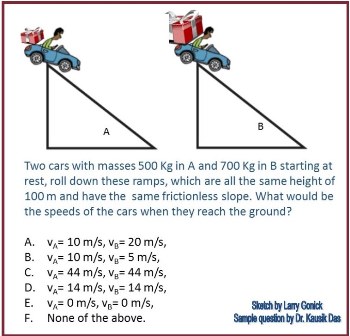UMES faculty, cartoonist team up to revamp curriculum
Friday, June 2, 2017
Drawing inspiration from the world of cartoon art, a team of University of Maryland Eastern Shore researchers has come up with a strategy to improve the success rate of students who take college physics courses.
Led by Dr. Kausik S. Das, the team has been awarded a $400,000 National Science Foundation grant to improve student engagement, boost retention and invigorate innovation through an inventive approach to physics instruction and senior-year research projects.
A major part of the process involves the creation of culturally and scientifically relevant “clicker questions” that researchers hope will motivate students to think more broadly and critically during lectures.
Das and three colleagues will partner with Larry Gonick, an award-winning cartoonist who taught mathematics at Harvard and cartooning at the Massachusetts Institute of Technology. Gonick will create more than “350 humanized clicker questions” spanning UMES’ undergraduate physics curriculum with the goal of engaging students with conceptually challenging questions – all served up with a touch of humor.
“My research team will supply those questions and as a consultant on the project (Gonick) will illustrate them with cartoons,” said Das, principle investigator and assistant professor of physics at UMES.
“College students across the country will benefit from the outcomes of this research,” Das said. “The skills a student learns in a physics classroom and a physics laboratory will take him or her far in life.

The first “clicker questions” will start appearing in the UMES curriculum this fall and Das said the team anticipates finishing the project in about a year.
The questions “will then be uploaded (to) a web page and made ‘open source’ so that we can see a global impact of this UMES project,” Das said. “We are expecting our collaborators from other countries to translate these questions in different languages also further down the line.”
The copyright of Gonick’s cartoons for the UMES project belongs to the university, Das said.
Capstone research projects, which are typically conducted during an undergraduate’s final year, will also put a premium on nurturing critical thinking skills, creativity, innovation, communication and collaboration among physics classmates as well as those in other disciplines.
In laboratories settings, instead of relying on traditional “cookbook” activities, the tweaks to the curriculum will guide students through stages of thinking analytically as well as interdisciplinary research projects with the goal of moving them toward “authentic discovery.”
Das was inspired to try this authentic discovery strategy at UMES following a visit he made to the University of California at Berkeley in 2016. Since then, he has scaled down several research projects to table-top projects, making them suitable for undergraduate students to explore a multitude of interdisciplinary research topics.
The researchers believe the strategy will lead to science and engineering students collaborating more effectively and efficiently in a group environment while growing intellectually and making original discoveries.
Among his mini-projects: synthesizing Nanoparticles using plant extracts, synthesis of graphene from a pencil lead and using it for energy harvesting and storage, Nanoparticle mediated heat transfer in fluids, paper-microfluidics and paper-electrophoresis, low Reynolds number turbulence, thermo-photovoltaics and Nanosensors.
Das noted several of these pilot projects have produced a start-up company by a UMES alumnus, a patent filing on a new metal oxide based memory device and several peer reviewed papers by undergraduate researchers.
In addition, two students Das supervises have received full scholarships from the University of Maryland and the University of Maryland, Baltimore County. They will pursue their doctorates after completing their undergraduate work at UMES. Another of Das’ students was accepted by UC-Berkeley as a summer research intern this year.
The team’s other researchers are: Dr. Moses T. Kairo, co-principle investigator and dean of the School of Agriculture & Natural Sciences; Dr. Charles Baldwin, assistant professor in the Department of Education and Dr. Joseph Dodoo, a physics lecturer. Robin Hoffman, UMES’ former director of instructional technologies, helped his colleagues put together the grant proposal.

